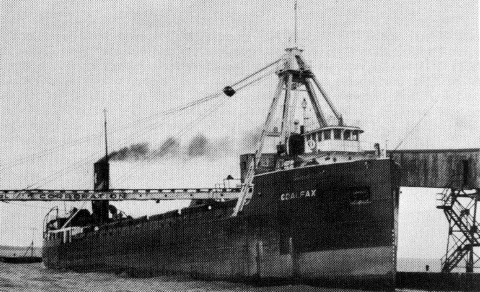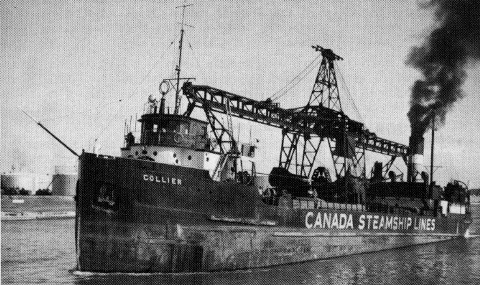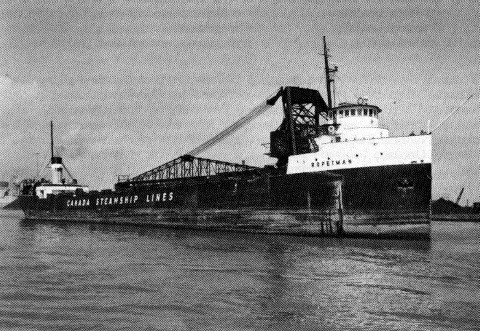In part one "April 12, 2000," I wrote about the Maitland
No 1's maiden voyage on a very stormy night in October, 1916.
In
this part I tell you what effect this ship had on the creation of
a cottage resort at the mouth of the Grand River, called Beckley
Beach.Coming on June 14th is a story that got its start from an
article in the Chronicle in January this year when Gord Mcleod
found the remains of a ship just off his marina.- "Is it the
Belladonna or is it the Elmira"
Part Two of
Maitland No One
Not Everyone was Amused
Not everyone was amused by
this great ship entering their "pond. She would run at least
ten months of the year and all year weather permitting. In a
recent letter, Mary Mullner, the daughter of Dolly Gray -former
owner of Dolly Gray Hotel at Port Maitland,- reminisces with Betty
Phillips, (Mrs. Gordon Phillips of Byng) about skating on the
smooth ice of the Grand River before the arrival of the car ferry.
Until the arrival of the Maitland No. 1, the river had long been
used by the children on both banks as their private skating pond.
Maitland No. 1, runs aground
On December 23, 1919, the ship was grounded for five days
on Lowes Point. Her sister ship, the Marquette-Bessemer No. 2,
pulled her safely off the reef after she shed her load of thirty
railway cars of coal, wire and one of oil, into Lake Erie. There
were plans to recover them the following spring. The issue as to
the existence of the wire and oil cars remains in dispute as those
who remember, and should know, say there were no wire or oil cars
on board. Some newspaper accounts immediately following the
incident however, state these cars were on board and dumped into
the lake. Isn't history fun? I have searched newspaper articles
following this accident and have found other newspaper accounts
mentioning only coal cars. Further research has not found
indication of the cars being recovered. You may recall an article
in the August 19, 1998 Chronicle titled AMysteries lurk in Lake
Erie's depths. In this article Angus Scott reported on the work
that a local diver by the name of Gerald MacDonald was doing to
find the lost rail cars from a ferry. The cars that Gerald was
looking for were those from the Maitland No. 1.
On
March 25, 1927, she ran aground on Tecumseh Shoal damaging her
hull. Maitland McKeown, a wheel man on board, recalls volunteering
to go ashore for provisions with a number of other crewmen. They
walked to shore on the ice and returned pulling sleighs loaded
with provisions. Mishaps were common on the lakes in those days.
It was only the year before that the Maitland No. 1, had been
involved in a thrilling rescue of sixteen men from the sand
sucker, Howard S. Gerkin, that sank during an August storm in
1926, with the loss of four crew members.
The Maitland
No. 1 is important to mention, not only for her capacity as an
early twentieth century freighter, but for how she altered the
course of Port Maitland. Only a handful of the current cottagers
recall seeing this ship. The Maitland No. 1, was small by today's
standards.
Most current summer residences who recall
any ship entering Port Maitland, remember the much larger coal
carriers, such as the Midland Prince and the R.O. Petman, formerly
known as the E.B. Osler. Other ships though not so large, to visit
Port Maitland were the Valley Camp, Charles Wilson, Coalhaven, and
Collier.
Had the TH&B not operated the ferry
service from Ashtabula to Port Maitland it is unlikely the
facility at Port Maitland would have developed. Other railways had
looked at running rail lines through of near Port Maitland but
none ever did. The TH&B was concerned about this and wanted to
reduce the competition. It has been suggested that the land on the
east side of the Grand River from Dunnville to Port Maitland was
purchased by the railway as a means of blocking access to the
Grand River by its competitors. If the railway had not determined
one full week could be cut from the delivery time of rail cars to
cities in Ohio and Pennsylvania by shipping them via Port
Maitland, there would have been no need to build the tracks to
Port Maitland. Had there not been tracks and a station at Port
Maitland, William J. Warnick, a young executive with the railway
in 1916, would not have had any reason to choose this location to
spend his summers.
It was through the efforts of W J
Warnick that Mr. Beckley first consented to rent tenting lots.
Eventually these lots were used for many of the cottages which
exist there today. WJ Warnick's son Joe, says the railway was not
very interested in the cottages, nor in anything on the south side
of the feeder. Their only interest was that Athe car ferry carry
her freight back and forth across Lake Erie on schedule. He
suggested, "It might have been a dream of his father's to
make Beckley Beach a nice resort place on Lake Erie.
When
we look at the list of early Beckley Beach cottagers we find;
Edward J. McNally, Edward F. Boyle, Manny Hurst, James
Grieghtmire, Michael Hayes, Jack Kelly, Joe Kelly, Hank Martin,
William McPherson, Steve Jones, Dr. James McGowan, Dr. Wm. Downes,
Father James A. Ford and Monsignor George Cassidy, to name only a
few. If we dig a bit further we will find their connection to the
TH&B as employees, or through a friendship with WJ Warnick. I
hear stories from old-timers that if you wanted to put up a tent
(later a cottage) at Beckley Beach and you did not know WJ Warnick
personally, you asked a friend to vouch for you. It would seem
that my grandfather decided who could come and who could
not!
Another interesting event that took place with the
arrival of the Maitland No. 1 was the purchase of land south of
the feeder canal which is where Beckley Beach is located. In June
1915, individual homesteads owned by many of the old Port Maitland
pioneers were purchased by John N. Beckley for $1.00 each,
totaling $14.00. Then within a day or two the combined package was
sold to the TH&B for a dollar. Remember, Mr. Beckley was the
President of the TH&B! One would wonder how he would have
survived in to-days real-estate market! Within two days he lost
$13.00 on his $14.00 transaction. There is clearly another story
here, but it will have to wait for another day.
Once
the TH&B had a station and a station agent, who by the way was
Thomas J. Kenney they began running a summer passenger service to
Port Maitland. They even ran advertisements in various city
newspapers expounding on the virtues of Port Maitland as a summer
resort. Rates at some of the local establishments were included in
railway ads. In a 1923 advertisement in the Hamilton Spectator,
the railway promotes local fishing. AGood Fishing at Port
Maitland; Good catches are brought in by parties spending the day
at the port. Take TH&B trains. Leaving at 9:02 a.m. and 2:13
p.m. Returning leaves Port Maitland 6 p.m. Service commences June
23.
The railway even promoted the YWCA and Boy Scout
camps where the Big Brothers also camped. WJ Warnick was also
involved with the Big Brothers being the President of the Hamilton
chapter, the first in Canada. WJ Warnick was very active in
getting the children from the Big Brothers organization to Port
Maitland and seeing to the religious needs of the Roman Catholic
children at both the YWCA camp and Scout camp.
If ever
there was one event that changed the course of time at Port
Maitland, it was the Maitland No. 1, introducing railway
management and workers to the sand and water of Beckley
Beach.
Due to a number of factors such as the opening
of the enlarged Welland Canal in 1932, the depression and other
markets for coal the need for the Maitland No. 1, decreased until
it was no longer feasible to operate. She made her last voyage on
June 28, 1932, to Ashtabula Ohio, as her service to Port Maitland
ended. She remained out of service until 1935, when she was leased
to the Nicholson Universal Steamship Company and put into service
carrying automobiles across Lake Michigan between Muskegon
Michigan and Milwaukee Wisconsin. Legal arguments over ownership
took her from service in 1937. With war looming she was
requisitioned by the American government who used her engines and
sold her hull. She was now reduced to a pulpwood barge.
The
purpose of this article was not to tell the story of the Maitland
No. 1. It was to give an understanding of what took place thus
setting the stage for the development of the cottage area on the
east side of the Grand River known as Beckley Beach. But what the
heck! She was an interesting ship and for many years a constant at
Port Maitland. Oh, and just to finish the story, the Maitland No.
1, continued a rather rag tag existence until she foundered in a
January storm in 1981. She had only days before been assigned
Honduran registration and renamed Trio Trado. She was under tow
and heading for a Mexican port, when off Yarmouth Nova Scotia she
rolled over and sank.
|

Coalfax

Collier

R O Petman
|

